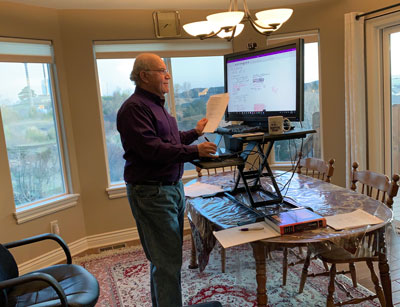April 17, 2020
A new look at university life: Lecture-only format proves successful when teaching from home

A major shift occurred on the K-State campus following spring break when the university made the switch to remote instruction.
Engineering faculty member Mo Hosni recently shared some experiences in online teaching of ME573 Heat Transfer, a required senior-level course for mechanical engineering students.
"Teaching from home is working well," said Hosni, professor of mechanical and nuclear engineering and the Charles and Nona Frankenhoff chair in engineering. "I have had no technology problems thus far, student attendance is great and they are participating well."
The class is a lecture-only format, with no labs involved. Enrollment size is dependent on the number of students in the program meeting the prerequisites to take the class.
"In the past this class has had about 60 students, but due to a very large increase in the department’s enrollment four years ago, the class size has expanded to between 90 to 95 enrollees,” Hosni said. “This semester is the largest class ever with 132 students."
The class meets on Mondays, Wednesdays and Fridays from 10:30 to 11:20 a.m. for a 50-minute-per-lecture period.
"Recorded lectures and online learning using Zoom are new since spring break, of course, when we switched to online teaching and learning," Hosni said. "Canvas announcements and discussions options are used now more frequently to communicate with students regarding common questions and homework assignments."
Hosni records each lecture period, consisting of topics from the original class schedule, using an electronic tablet and Camtasia recording software. Each recorded lecture is uploaded to the Mediasite of Canvas the day before the normal class period so that students can view the lecture.
During each lecture period, students join the class via Zoom. Hosni gives a brief review of the topics covered in the recorded lecture and students can ask any questions just as they would in a classroom by raising their hand electronically in Zoom, or they can use the chat function of Zoom to ask questions or share information with the rest of the class.
"Then I work sample problems related to the topics covered in the lecture," he said, "and assign the same number of homework problems as we had when we met face-to-face. The difference here is the students complete their homework assignments and upload them to Canvas where a TA grades them and posts their score."
Attendance has been strong with approximately 95% of students logging on to the lectures. Some are even gathering in small groups to watch together. Hosni said he knows of two students in Wamego who watch the lectures using the same PC.
"The switch to online classes has given students more opportunities for learning than a regular class because now they can go back and review the lectures multiple times at their convenience," he said, "and due to the recorded lectures, less time is spent on the lecture itself, allowing more time to work sample problems and answer questions during class."
Two students who had missed the second exam of the semester due to a job interview and an illness were even given a make-up exam after spring break using Zoom.
"They turned on their Zoom at home, and I emailed them the exam and watched them download it and have 80 minutes to complete the test, just as they would have done in the class exam period," Hosni said. "I was able to observe their progress and answer any questions. Then they emailed it back to me for grading and, wow — it worked great!"
Hosni said he does miss the face-to-face interaction with students and being available to help them with personal issues, adding that his work load has changed somewhat as well.
"The time and effort I am putting into this course now are probably more than lecturing in the classroom," he said, "but again, student learning has been and continues to be my No. 1 priority. I am happy to do whatever it takes to help them master the material."
